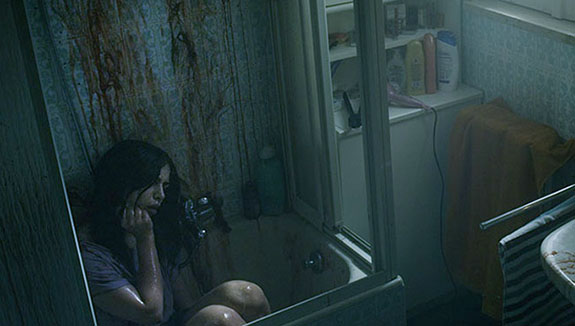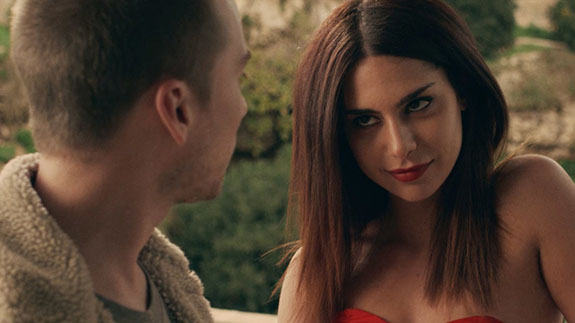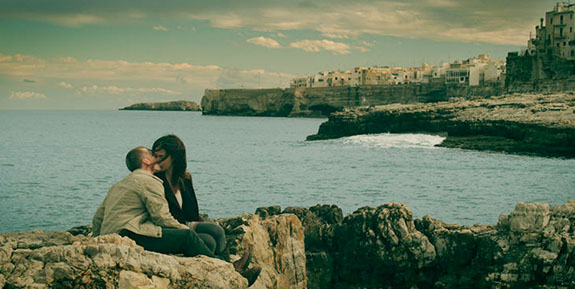
Evan is having what might be the worst week of his life. His mom just died, and some drunk-ass Angeleno with a chrome smile wants to start some shit in the bar where Evan works. Evan punches the chrome out of the jerk’s mouth, and before Evan can finish a cigarette, he’s been fired. Later, Chrome Smile drops by Evan’s house for a friendly visit. Things don’t get better the next morning when the cops come knocking. Left with a meager inheritance, Evan uses it to skip town and ends up in Italy. While visiting a picturesque coastal town, Evan meets Louise, the girl of his dreams… and she has a monstrous secret.
Directed by Justin Benson and Aaron Moorhead (makers of the cerebral meta-horror Resolution), Spring is a solidly written and well acted horror romance in the vein of An American Werewolf in London and 1982’s Cat People. Structurally, Spring is a romance, but the goopy practical creature effects and shocking reveals make it well suited for horror fans who don’t mind a bit of genre crossover.

Lou Taylor Pucci (the bespectacled pincushion of Evil Dead) has a lot of weight on his shoulders as Evan, but he carries it like a champ. He nails his emotional beats, he’s funny, his cadence is natural and heartfelt, and his chemistry with Nadia Hilker (who is just as funny and excellent) makes for a strong narrative backbone. Both roles offer strong dramatic potential — a series of family tragedies forced Evan to put his education on hold and he got stuck in a shit job. Louise is guarded and fickle (with reason), but she’s also a brilliant scientist, doing genetics research in an attempt to learn more about her mysterious condition. Evan’s sharp wits allow him to keep up with her when she’s teasing him over gelato or spouting exposition later in the film.
Pucci and Hilker are the two are the biggest reasons why Spring works — even though Evan falling head-over-heels in love with Louise in a matter of days is a hard pill to swallow. This may be because Spring omits the trope of the falling-in-love montage found in most romance films. Instead, we invest their relationship through scenes of meaningful and well-written dialogue, a lot of which feels improvised. Contributing to that improvised feel is the film’s cinematography — mostly handheld, creating a less constructed look. For spectacle, Benson and Moorhead make good use of drones to capture soaring, swooping shots that add a huge amount of scope and production value to an otherwise intimate film.

Another contributing factor to this small, improvised feel is the lighting: it looks like nearly every scene in the film was captured with natural or available light. For a filmmaker, available light is a blessing and a curse. You can save time and money by skipping the lighting setup, but you’re also at the mercy of the sun, the weather, and whatever crummy lighting your location might have. The reward is that using available light can look unbe-fucking-lievable (see: Terrence Malick). In Spring, the available light cinematography looks natural and real… but it doesn’t look GOOD. That’s a big problem, and it contributes to my single biggest issue with the film: you can’t tell from the stills I’ve chosen for my review, but Spring doesn’t look very good. Like, at all.
Just to clarify, I rented the film in HD from the iTunes Store and I watched it on my computer monitor (which is calibrated). The trailer on YouTube looks about the same, so I don’t think it’s an issue with the iTunes copy. It all comes down to creative choice, but I think the root of the problem is in technology. The dynamic range on today’s digital cinema cameras is really wide, so the raw image doesn’t have enough contrast. If the footage isn’t properly handled by a colorist, nearly everything will be washed out. Flat-looking, no depth. Black looks like gray, and colors lack vibrancy. It looks soft, mushy. This look plagues nearly every scene. And what’s even more frustrating is that the movie is pretty heavily color graded. In many scenes, certain areas of the frame have obviously been brightened in post production to compensate for issues with lighting. Maybe the film looks better in theaters. Maybe it’ll look different on Blu-Ray. I don’t know. All I know is that it affected my experience negatively. Luckily, with writing so solid, performances so good, and practical effects so cool (there’s some dodgy CGI, too), I’m still willing to recommend Spring to just about anyone with a taste for horror. It’s in limited theatrical release now, but is also available on iTunes and other VOD platforms.
Rating: 




Out of a Possible 5 Stars